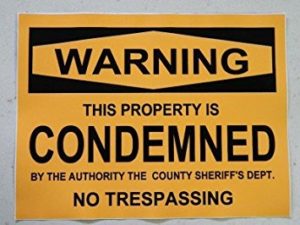Suzette Kelo bought what she thought was her dream house, a little pink cottage in Connecticut with a great view, where the Thames River flows into Long Island Sound. She lovingly restored the home, but her dream didn’t last. When a pharmaceutical plant was built nearby, the City of New London decided the residential section would generate a lot more tax revenue if occupied by larger and more expensive commercial buildings. So, the town council turned over its power of “eminent domain” to a private development company, all the homes in the neighborhood were condemned, the residents forced out, and their homes torn down or moved away.
 The developers went broke and abandoned the project, so Suzette’s quaint neighborhood is now a parking lot. She and several neighbors, some of whom had lived there for generations, sued the city, which had used its right to condemn private property, not for public use, but to transfer ownership to a different private owner. In one of its most controversial decisions, the U.S. Supreme Court sided with the City, ruling that economic development (i.e. upgrading the value of a neighborhood) is a “public use” under the Fifth Amendment.
The developers went broke and abandoned the project, so Suzette’s quaint neighborhood is now a parking lot. She and several neighbors, some of whom had lived there for generations, sued the city, which had used its right to condemn private property, not for public use, but to transfer ownership to a different private owner. In one of its most controversial decisions, the U.S. Supreme Court sided with the City, ruling that economic development (i.e. upgrading the value of a neighborhood) is a “public use” under the Fifth Amendment.
That was 12 years ago, and it sparked enough public outrage that 43 States have now strengthened protections for private property against local condemnation powers. The Fifth Amendment is an essential part of the Bill of Rights, ensuring among other things, “nor shall private property be taken for public use without just compensation.” The founders understood, of course, that sometimes private property stands in the way of public progress, such as when highways are built. The public good cannot be held hostage by one owner, whose refusal to sell might otherwise block needed transportation or other infrastructure projects. Thus, all governments have the right of “eminent domain” to handle such cases, and they must pay owners the fair market value of land thus taken for public use.
What is a “public use” under the law? The Supreme Court determined in the 1950s that elimination of slums and blight could be considered an important public purpose, in another landmark case involving the slums of Southwest Washington, D.C. It’s hard to imagine now, but at the time, 64 percent of the homes in that quadrant were found to be “beyond repair.” Over 60 percent of them had no bathrooms and some didn’t even have outhouses. Almost a third had no electricity, 82 percent had no laundry tubs, and 84 percent had no central heat. A comprehensive plan was created and the local government’s eminent domain powers were used to tear down blocks of slums, which are now occupied by government buildings and hotels. But isn’t there a difference between the public’s interest in eliminating slums, and a city’s desire to enhance its revenue by turning over one person’s property to another owner who promises to build something bigger?
The Supreme Court said there is not a difference, but public opinion has clearly said otherwise, which is why most States now prohibit what the city of New London did to Suzette Kelo. But some towns don’t actually take away a property’s deed, just its value.
David Lucas bought two lots on a barrier island near Charleston; then the South Carolina Coastal Commission changed the zoning laws, prohibiting the two houses he planned to build. His lawsuit went all the way to the Supreme Court, which re-affirmed the Fifth Amendment prohibition against government taking private property for public purposes without just compensation – even when the “taking” is of the land’s value, rather than its actual title.
Just four years later, though, Jim Wickstra bought a 3-acre parcel on Lake Michigan, intending to build a beach home. A few months later, the Legislature passed a law to stop development along the lakefront. Mr. Wickstra’s permit was then denied. The State tax agency ruled that the property was worth $200,000 with a building permit and only $500 without it. Yet he spent more than a decade fighting to get compensation for the loss of his property value, unsuccessfully. The courts ruled that $199,500 was an insufficient decline in value to justify compensation.
Courts have been all over the map on this issue, so legislatures need to address it. Property values may be substantially reduced for perfectly legitimate public purposes (such as open space preservation). But a society willing to take away that value must also be willing to compensate the owners from whom it is taken. It’s one of America’s founding principles.
A version of this column originally appeared in the Grand Junction Daily Sentinel September 1, 2017.




Comments on this entry are closed.